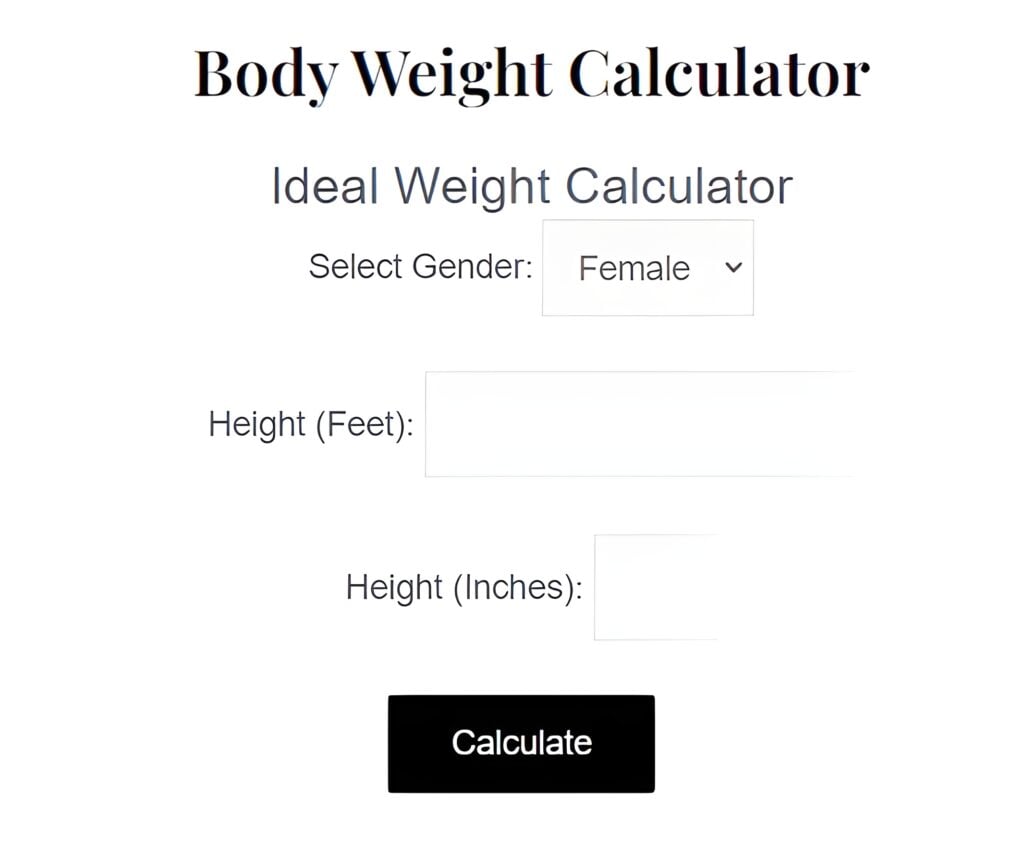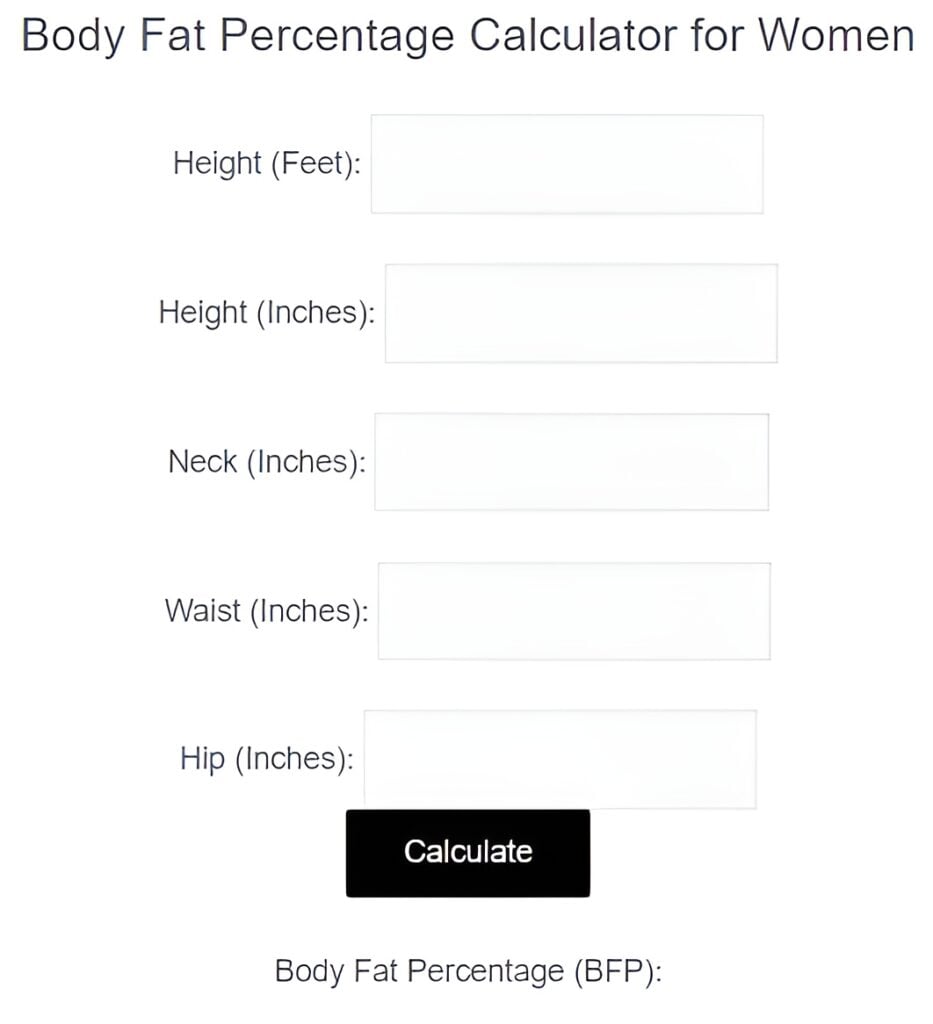
The Body Fat Calculator is a nifty tool designed to provide valuable insight into your body composition, enabling you to understand your overall health and create an individualized diet and exercise plan. Whether you are trying to lose weight, build muscle, or improve your overall well-being, the Body Fat Calculator is an excellent place to start.
The ideal percentage ranges vary between men and women. For men, a healthy range is typically between 8-19%, while for women, it should be between 21-33%. Body fat calculators can help determine your percentage based on factors such as height, weight, and age, and guide you towards the ideal range.
Table of Contents
However, keep in mind that body fat percentage isn’t a definitive measure of health. Factors such as muscle definition, genetics, and lifestyle habits can influence your results.
For instance, an athlete who works out regularly may have a higher percentage of muscle mass, resulting in a lower body fat percentage, while someone with a sedentary lifestyle may have a higher percentage of body fat, even if they are within a healthy BMI range.
The scientific term for body fat is “adipose tissue.” This tissue plays a vital role in the human body. It’s responsible for storing lipids that your body uses to create energy, regulate hormones, and provide cushioning and insulation.
But not all body fat is the same. There are two types of body fat.
- Essential
- Storage Fat
Essential fat is the base level of fat found mainly in organs, bone marrow, and muscles, which is critical for maintaining normal body functions. Men and women have different levels of essential fat. Men should expect to have around 2-5%, while women’s bodies should contain 10-13%.
Having less than these percentages can have negative health effects including hormone imbalances and decreased bone density. Having too much essential fat is also undesirable and can clog blood vessels and impact other parts of your body.
The Link Between Weight and Health
When we talk about body fat, we tend to refer to storage fat. Storage fat is the fat that accumulates in adipose tissues, including subcutaneous and visceral fat and is responsible for most body fat percentage references.
Subcutaneous fat builds up below the skin surface while visceral fat collects around internal organs in the abdominal area. While some storage fat is essential for good health, having too much can increase the risk of health conditions such as diabetes and heart disease.

Are Body Fat Calculators Accurate?
There are various ways to measure body fat and each method varies in accuracy and cost. The most accurate and reliable method is through hydrostatic weighing where you are submerged in water to determine your body fat percentage.
Other methods such as Dual-Energy X-ray Absorptiometry (DEXA), bioelectrical impedance, and skinfold calipers are also commonly used. While hydrostatic weighing is the most accurate method, it is not easily accessible to the general population due to cost and availability. DEXA is also highly accurate but is expensive and requires specialized equipment.
Bioelectrical impedance analysis and skinfold calipers are affordable and easy to use, but they are less accurate than the other methods.
Body fat calculators use various equations that factor in age, gender, height, weight, and other measurements to estimate one’s body fat percentage. These calculators are far more accessible and affordable than other methods but may not be as accurate. Body fat calculators rely on estimations and assumptions, which can lead to errors.
Some calculators may assume a certain level of lean muscle mass, which can vary from person to person. Additionally, body fat calculators do not consider the distribution of body fat which can be an essential factor in determining overall health risks.
It is essential to keep in mind that body fat percentage is just one aspect of overall health and fitness. Other factors such as blood pressure, cholesterol levels, and physical fitness all play critical roles in determining overall health.
While body fat calculators may not provide the most accurate measurement of body fat percentage, they can still give a general idea and be used as a starting point for tracking progress. By using the same calculator consistently, a person can track changes in body fat percentage over time, even if the absolute number may not be entirely accurate.
The Risks Associated with Excess Body Fat
One of the immediate effects of excess body fat is a reduction in quality of life. People who are overweight or obese may experience challenges with daily activities such as walking, climbing stairs, or even fitting into tight spaces. This can lead to a lack of exercise and physical activity, which can further contribute to weight gain and the development of other health complications.
Obesity has also been linked to poorer mental health outcomes. Studies have found that people who are overweight or obese may experience depression, anxiety, and low self-esteem. The stigma associated with obesity can also lead to social isolation which can negatively impact a person’s mental health.
The Best Recommendations from Dietitians for Effective Weight Loss
Excess body fat around the neck can lead to obstructive sleep apnea, a condition that causes interrupted breathing during sleep. Sleep apnea can have a significant impact on your quality of life and lead to daytime fatigue and increased risk of accidents.
Fat produces essential hormones that affect your body. An excess or a lack of critical hormones can have negative effects that preclude proper body function. Studies have found that excess body fat, particularly abdominal fat, disrupts the normal balance and function of some of these hormones, leading to hormonal imbalances that can contribute to health complications.
Measuring Body Fat Percentage
The U.S. Navy Method is a simple but reliable technique for measuring body fat percentage. The method requires taking three measurements and using specific formulas to produce an accurate estimate. The measurements required are the waist circumference, neck circumference, and hip circumference (for women only).
Once you obtain these measurements, you can use a body fat calculator to determine your body fat percentage. The calculator uses the specific equations developed by Hodgdon and Beckett in 1984 at the Naval Health Research Center.
This invention was groundbreaking at the time and has since become a widely used tool for health professionals and fitness enthusiasts alike. Thanks to Hodgdon and Beckett’s hard work and dedication, we now have a much better understanding of our bodies and how to maintain good health.
Obtaining Correct Measurements
For this method to produce accurate results, it is essential to take the correct measurements. First, measure the circumference of the waist at the navel level for men and at the smallest width for women.
Ensure that you do not pull your stomach inwards and maintain a relaxed pose. Next, measure the circumference of your neck below the larynx with the tape sloping downwards to the front and stop flaring up the neck.
Lastly, for women, measure the circumference of the hips at the largest horizontal measure.
Using the Formulas
Once you have completed taking the three measurements, use the corresponding formulas to calculate your body fat percentage. Use the USC formula (using inches) for the waist and neck measurements taken in inches.
For women, input the hip measurement in inches, also using the USC formula. For all measurements taken in centimeters, use the formula meant for the International System of Units. Plug in the measurements into the appropriate formula and use a calculator to determine your body fat percentage.

What’s A Healthy Body Fat Percentage?
There is no single answer to the question of what constitutes a healthy body fat percentage. It varies based on several factors, including age, gender, and overall fitness level.
Generally, a healthy body fat percentage for men ranges from 10% to 20%. While for women, the healthy range is typically 15% to 25%. It is important to remember that the body fat percentage is only one of determining fitness level and overall health. It is always best to speak with a healthcare professional to interpret the results.
Different Types of Fitness Calculators
The BMI Calculator is a widely used tool that calculates your body fat levels using your height and weight measurements. While it is one of the most traditional tools used to indicate obesity problems, it doesn’t take into account our body’s composition and may not be as accurate as other more specific tools.
The Calorie Calculator gives you an estimate of your daily caloric intake based on your age, sex, height, and weight. It can be helpful because it helps you understand how much you should be eating to lose, maintain, or even gain weight.
How to Calculate Your Calorie Needs to Lose Weight Safely
However, it is essential to remember that this is just a rough estimate. Everyone’s metabolism is different and you may need to adjust the number of calories you consume based on your activity levels and goals.
Body Fat Calculator is considered one of the best weight loss calculators because it gives you a precise estimate of your body fat percentage by taking various factors such as age, BMI, and waist measurement into account. It helps you understand how much of your weight comes from lean tissue and fat. Adopting a diet plan according to your body fats promotes healthy eating behavior while losing weight or gaining muscles.
The BMR Calculator estimates the number of calories you can burn per day while your body is at rest. It helps in finding how much food you need to take in to lose belly fat or maintain muscle without regaining weight.
However, this calculator’s disadvantage is that it does not take into account the current exercise schedule so it may not give you the full story of your daily caloric needs.
The Ideal Weight Calculator calculates your ideal weight according to your age, sex, and height. It can be beneficial if you have a long-term weight loss goal. But again, it only gives you an estimate.
The ideal weight calculator may not take into account muscle mass, bone density, and other factors that affect your weight, so it is best to use this calculator as one of several resources to inform your weight loss journey.
Pros and Cons of BMI, Calorie, Body Fat, BMR, and Ideal Weight Calculators
Body Mass Index (BMI)
Pros:
- Provides a general indication of your health status.
- It’s easy to use, and different online calculators provide quick results.
- Helps you determine your ideal weight range.
Cons:
- It doesn’t take into account your muscle mass, which could provide inaccurate results.
- People with the same BMI score might have different amounts of body fat, which could lead to confusion.
- Does not measure body fat directly.
Calorie Calculator
Pros:
- It helps you determine the best calorie deficit needed to lose weight.
- Takes into account your physical activity levels, which is important when creating weight loss plans.
- Can provide a customized diet and workout plan based on your fitness goals.
Cons:
- It cannot account for individual differences in metabolic rates.
- Does not consider your hormonal imbalances, food allergies, intolerances, or diseases that could affect your metabolism.
- It relies on estimation rather than measurement.
Body Fat Calculator
Pros:
- It provides a more accurate measurement of your body fat percentage.
- Can serve as a better indicator of your health status than BMI.
- Keeps track of the effectiveness of your fitness and diet routines.
Cons:
- Different types of body fat calculators provide different results, making comparisons difficult.
- It’s not as easy to use as BMI or calorie calculators.
- It might require consistent measuring and tracking to provide valuable insights.
Basal Metabolic Rate (BMR) Calculator
Pros:
- It indicates your metabolic rate and energy expenditure.
- Helps determine the appropriate calorie deficit needed to lose weight.
- Provides a more accurate estimation of calorie consumption.
Cons:
- It doesn’t account for individual differences in metabolic rates due to factors such as age, gender, or lifestyle.
- Estimations might still vary from person to person, making it difficult to plan according to the exact caloric need.
- It’s not a reliable tool for athletes or people with higher activity levels.
Ideal Weight Calculator
Pros:
- Provides a useful guideline to determine your ideal weight range.
- Helps you set realistic weight loss goals.
- It can motivate you to achieve your fitness goals.
Cons:
- Ideal weights can vary from one formula to another and are not always accurate.
- It doesn’t consider your body composition, muscle mass, or overall health status.
- It’s an ideal weight range, which doesn’t account for individual differences.
Ideal Body Weight
Ideal Body Weight (IBW) was initially developed as a way to calculate drug dosages based on the patient’s body weight.
However, it has since been used in other fields such as sports, where athletes are classified based on their weight. But here’s the catch – the formulas used to calculate IBW do not take into account factors such as a person’s muscle and body fat percentages.
It is possible for highly fit, healthy athletes to be considered overweight based on their IBW. Therefore, it’s crucial to understand that IBW should be viewed as an imperfect measure and not considered as an indicator of health.
There is no magical weight that a person should strive for regardless of the measurement used. Each person’s ideal weight is highly dependent on individual factors such as genetics, age, lifestyle, medical history, and more.
More and more research studies are beginning to suggest that body composition and the distribution of fat play a more significant role in a person’s health than simply their weight. Hence, weight should not be taken as the sole indicator of a person’s overall health.
The Body Mass Index (BMI) is another commonly used metric for measuring health status. It’s calculated by dividing a person’s weight (in kgs) by the square of their height (in meters). Although often used for screening obesity, BMI has several flaws.
- First, it’s not an accurate measure of a person’s body fat percentage, which is much more important for health.
- Secondly, factors such as age, ethnicity, and sex have been shown to influence the relationship between BMI and body fat.
Moreover, many athletes and muscular individuals can end up being labeled as overweight or obese based on BMI.
The myth of the ideal body weight can thus be debunked from a health perspective. A more comprehensive understanding of a person’s health involves more than just measuring one’s weight, BMI, or IBW.
Factors such as eating habits, exercise, sleep quality, stress levels, mental health, and overall well-being should be prioritized over achieving a certain number on the scale. It’s important to note that everyone’s body works differently and no two individuals are the same.
Therefore, it’s always better to consult a certified healthcare provider who can provide personalized guidance toward optimal health.
Relationship Between Age and Body Weight
After adolescence, age should not determine an individual’s ideal body weight. Most people stop growing at age 14-15 for girls and 16-17 for boys. However, as we age, our body composition changes, including a gradual decrease in muscle mass and an increase in body fat.
These changes can significantly impact our weight and overall health.
Gender plays a crucial role in determining body weight. Females naturally weigh less than males despite having a higher percentage of body fat. This is because males have higher muscle mass which is heavier than fat and females tend to have lower bone density.
Additionally, males are generally taller than females, which also impacts their body weight.
Another significant factor that influences body weight is height. Taller people tend to have more muscle mass and body fat which results in more weight. A male at a similar height to a female should weigh about 10-20% more.
Healthy BMI Range
Body mass index or BMI is an essential indicator of overall health and well-being. It is calculated based on a person’s weight and height, and the World Health Organization has set healthy BMI ranges between 18.5 to 25 for males and females.
Body mass index is a measurement used to determine if a person’s weight is within a healthy range. It is calculated through a simple mathematical formula, which divides weight by height squared.
Although it doesn’t directly measure body fat, it is used as a screening tool to identify potential risks in individuals’ health.
People with high BMI have an increased risk of chronic diseases such as heart disease, stroke, diabetes, and certain types of cancer. Being overweight or obese can also affect your mental health and cause low self-esteem, anxiety, and depression.
While the World Health Organization recommends a BMI range of 18.5 to 25 for adults, children, and teens have different BMI ranges depending on their age and gender. The CDC recommends that children maintain a BMI between the 5th and 85th percentile based on their age.
Are Americans at Their Ideal Weight
According to the Centers for Disease Control and Prevention (CDC), more than two-thirds (70.2%) of American adults aged 20 and over are overweight or obese. Only 29.8% have a healthy BMI.
Childhood obesity is a growing problem in the United States as well. According to the CDC, almost 1 in 5 (18.5%) of children and adolescents aged 2-19 were obese.
Why are so many Americans overweight or obese?
There are many factors including a lack of physical activity, poor diet, genetics, and environmental factors. In addition, certain medications and medical conditions can contribute to weight gain.
What can be done to help Americans reach their ideal weight?
The simple answer is to eat a healthy diet and get regular exercise. This can include things like eating more fruits and vegetables, choosing lean protein sources, and limiting processed foods and sugary drinks.
In addition, getting at least 150 minutes of moderate-intensity exercise per week can help improve health and promote weight loss. However, it’s important to talk to a healthcare provider before starting any new diet or exercise program.
Contact us today
Email:
Phone: (346) 593-5619
Contact Human Resources
HumanResources@herweightloss.com
Contact Operations
Contact Authors for Her Weight Loss
AuthorContact@herweightloss.com
Customer Service
source https://herweightloss.com/body-fat-calculator-2/

No comments:
Post a Comment